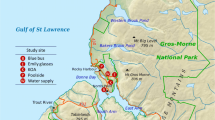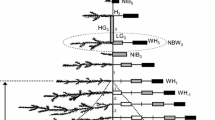Abstract
The balsam woolly adelgid (Adelges piceae) is a gout-inducing hemipteran native to the silver fir forests of Europe. Introduced to eastern North America approximately 100 years ago, it is now found in most balsam fir forests in Atlantic Canada. When A. piceae feed, they trigger a reaction in the host branch that alters both xylem and phloem morphology. We conducted a field survey to examine the relationship between A. piceae gout density and balsam fir foliar chemistry and shoot growth in naturally unthinned and precommercially thinned stands. A. piceae gout density negatively affected branch growth and was related to changes in the chemistry of older, but not current-year foliage. Older foliage experienced decreases in camphene and bornyl acetate, while foliar concentrations of camphene, myrcene, phenolics, potassium and water differed between thinned and unthinned stands. Foliar chemistry was also influenced by interactions between thinning and A. piceae gout density in old foliage. This study suggests that changes in balsam fir associated with A. piceae gout density may force native defoliators that feed in highly gouted trees to adapt to diets of different chemical compositions and that thinning may alter these interactions.





Similar content being viewed by others
References
Arendt JD (1997) Adaptive intrinsic growth rates: an integration across taxa. Q Rev Biol 72:149–177
Balch RE (1952) Studies of the balsam woolly aphid, Adelges piceae (Ratz) and its effect on balsam fir Abies Balsamea (L) Mill. Can Dept Agric Publ 867:1–76
Bauce É (1996) One and two years impact of commercial thinning on spruce budworm feeding ecology and host tree foliage production and chemistry. For Chron 72:393–398
Bauce É, Crépin M, Carisey N (1994) Spruce budworm growth development and food utilization on young and old balsam fir trees. Oecologia 97:499–507
Carisey N, Bauce E (2002) Does nutrition-related stress carry over to spruce budworm, Choristoneura fumiferana (Lepidoptera: Tortricidae) progeny? Bull Entomol Res 92:101–108
Carroll WJ, Bryant DG (1960) A review of the balsam woolly aphid in Newfoundland. For Chron 36:278–290
Cates RG, Redak RA, Henderson CB (1983) Patterns in defensive natural product chemistry: Douglas fir and western spruce budworm interactions. In: Hedin PA (ed.) Plant resistance to insects. Am Chem Soc 208, Washington, pp. 3–19
Chapin FS (1991) Integrated responses of plants to stress. Bioscience 41:29–36
Clancy KM (1992) The role of sugars in western spruce budworm nutritional ecology. Ecol Entomol 17:189–197
Clancy KM, King RM (1993) Defining the western spruce budworm’s nutritional niche with response surface methodology. Ecology 74:442–454
Dickson RE (1979) Analytical procedures for the sequential extraction of 14C-labeled constituents from leaves, bark and wood of cottonwood plants. Physiol Plant 45:480–488
Doerksen AH, Mitchell RG (1965) Effects of the Balsam woolly aphid upon wood anatomy of some western true firs. For Sci 11:181–188
Dolgin B, Schechter I, Asido S, Bonfil DJ (2005) Improvements for digestion of whole grains and plant matter for phosphorous and potassium. Comm Soil Sci Plant Anal 36:1747–1761
Fuentealba A, Bauce É (2012) Site factors and management influence short term host resistance to spruce budworm (Choristoneura fumiferana (Clem)) in a species-specific manner. Pest Manag Sci 68:245–253
Hagerman AE (1987) Radial diffusion method for determining tannin in plant extracts. J Chem Ecol 13:437–449
Hain FP (1988) The balsam woolly adelgid in North America. In: Berryman AA (ed) Dynamics of forest insect populations: patterns causes implications. Plenum, New York, pp 87–109
Hain FP, Hollingsworth RG, Arthur FH, Sanchez F, Ross RK (1991) Adelgid host interactions with special reference to the balsam woolly adelgid in North America. In: Baranchikov YN, Matison YN, Hain FP, Payne TL (eds) Forest insect guilds: patterns of interaction with host trees. USDA For Serv Gen Tech Rep NE-153
Ho LC (1988) Metabolism and compartmentation of imported sugars in sink organs in relation to sink strength. Ann Rev Plant Physiol Plant Mol Biol 39:355–378
Honkanen T, Haukioja E, Suomela J (1994) Effects of simulated defoliation and debudding on needle and shoot growth in Scots pine (Pinus sylvestris): implications of plant source/sink relationships for plant-herbivore studies. Funct Ecol 8:631–639
Kotinsky J (1916) The European fir trunk louse Chermes (Dreyfusia) piceae. Ratz. Proc Entomol Soc Wash 18:14–16
Kramling ET, Singleton VL (1969) An estimate of the nonflavonoid phenols in wines. Am J Enol Vitic 20:86–92
Lamontagne M, Bauce É, Margolis HA (2002) Testing the ecophysiological basis for the control of monoterpene concentrations in thinned and unthinned balsam fir stands across different drainage classes. Oecologia 130:15–24
Larson KC, Whitman TG (1997) Competition between gall aphids and natural plant sinks: plant architecture affects resistance to galling. Oecologia 109:575–582
Mattson WJ, Slocum SS, Koller CN (1983) Spruce budworm (Choristoneura fumiferana) performance in relation to foliar chemistry of its host plants. In: Proc Forest Defoliator-Host Interactions: a comparison between gypsy moth and spruce budworm. USDA For Ser Gen Tech Rep NE-85 ME. Forest Exp Sta Hamden CT, pp 55-65
Miller-Pierce MR, Orwig DA, Preisser E (2010) Effects of hemlock woolly adelgid and elongate hemlock scale on eastern hemlock growth and foliar chemistry. Environ Entomol 39:513–519
Mitchell RG (1967) Abnormal ray tissue in three true firs infested by the balsam woolly aphid (Adelges piceae). For Sci 13:327–332
Mullick DB (1975) A new tissue essential to necrophylactic periderm formation in the bark of four conifers. Can J Bot 53:2443–2457
Mullick DB (1977) The non-specific nature of defense in bark and wood during wounding insect and pathogen attack. In: Loewus FA, Runeckles VC (eds) Recent advances in phytochemistry, vol 11. Plenum Publishing Co, New York, pp 395–441
Pothier D (2002) Twenty-year results of precommercial thinning in a balsam fir stand. For Ecol Manag 168:177–186
Puritch GS (1971) Water permeability of the wood of Grand fir (Abies grandis (Doug) Lindl) in relation to infestation by the balsam woolly aphid, Adelges piceae (Ratz). J Exp Bot 22:936–945
Puritch GS, Johnson RPC (1971) Effects of infestation by the balsam woolly aphid, Adelges Piceae (Ratz) on the ultrastructure of bodered-pit membranes of Grand Fir, Abies grandis (Doug) Lindl. J Exp Bot 22:953–958
Puritch GS, Petty JA (1971) Effect of balsam woolly aphid, Adelges piceae (Ratz) infestation on the xylem of Abies grandis (Doug) Lindl. J Exp Bot 22:946–952
Quiring D, Ostaff DP, Hartling L, Lavigne D, Moore K, DeMerchant I (2008) Temperature and plant hardiness zone influence distribution of balsam woolly adelgid damage in Atlantic Canada. For Chron 84:558–562
Ragenovich IR, Mitchell RG (2006) Balsam woolly adelgid. US Dept Agric For Serv Forest insect and Disease Leaflet (FIDL) #118
Redak RA, Cates RG (1984) Douglas-fir (Pseudotsuga menziesii)-spruce budworm (Choristoneura occidentalis) interactions: the effect of nutrition, chemical defenses, tissue phenology, and tree physical parameters on budworm success. Oecologia 62:61–67
SAS institute (2010) Base SAS ® 9.3 Procedures Guide. SAS institute Inc., Cary, North Carolina
Schoonhoveen LM, van Loon JJA, Dicke M (2005) Insect—plant biology. Oxford University Press, Oxford
Smirnoff WA, Bernier B (1973) Increased mortality of the Swaine jack-pine sawfly and foliar nitrogen concentrations after urea fertilization. Can J For Res 3:112–121
Speight MR, Hunter MD, Watt AD (2008) Ecology of insects. Wiley, Chichester
Timell TE (1986) Compression wood in gymnosperms, volumes 1–3. Springer, Berlin
Wisdom CS, Gonzalez-Coloma A, Rundel PW (1987) Ecological tannin assays evaluation of proanthocyanidins protein binding assays and protein precipitating potential. Oecologia 72:395–401
Acknowledgments
We thank T. Brown, B. Butler, C. Butt, N. Drummond, M-P. Godine, N. Grégoire, B. Organ, T. Rideout, K. Strath, C. Travers, E. Wheeler and S. Wilcox for assistance in the field and laboratory; M. Charest, P. Huron, N. Giasson and L. Seehausen for assistance conducting chemical analyses; A. Morison and G. Butt for assistance locating sites; G. Moreau, S. Heard and L. Jesson for statistical advice; Corner Brook Pulp and Paper for access to sites; and Natural Resources Canada, Canadian Forest Service, and Newfoundland and Labrador Department of Natural Resources for the use of facilities and resources. Financial support was provided to the iFor Research Consortium by the Natural Sciences and Engineering Research Council of Canada (NSERC-CRSNG), the Ministère des Ressources naturelles et de la Faune du Québec (MRNFQ), the Conseil de l’Industrie Forestière du Québec (CIFQ), the Canadian Forest Service and the Société de Protection des Forêts contre les Insectes et les Maladies du Québec (SOPFIM).
Author information
Authors and Affiliations
Corresponding author
Additional information
Communicated by Anna-Karin Borg-Karlson.
Rights and permissions
About this article
Cite this article
Grégoire, D.M., Quiring, D.T., Royer, L. et al. Relationship between an exotic phloem feeder and balsam fir (Abies balsamea L. (Mill.)) foliar chemistry: implications for two native defoliators. Arthropod-Plant Interactions 8, 361–371 (2014). https://doi.org/10.1007/s11829-014-9317-0
Received:
Accepted:
Published:
Issue Date:
DOI: https://doi.org/10.1007/s11829-014-9317-0




